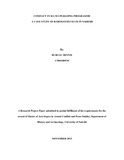| dc.description.abstract | The purpose of this study was to find out the factors linking conflict and development, with particular example of the slum upgrading in urban areas in Kenya. The study was focused in Korogocho Slum area which is located in the Kasarani Division, in Eastern Nairobi. Korogocho borders the largest Dumping Site in Nairobi which poses environmental health and security risk for the residents and the surrounding settlements. The specific objectives of the study were to investigation the informal settlement in Korogocho Slums and the impact of the Kenya Slum Upgrading Programmes. The study was also to examine the linkage between the Upgrading Programme and conflict in slums. Through the use of secondary and primary data the study established that the residents were not participate in the initial implementation of the programme. This was key in the sustainability of the programme. The programme also did not adequately achieve some of its objectives which include, housing, poverty, health and most of the issues that affected the slum dwellers. Land tenure which was the main cause of conflict between the landlords and the tenants was not adequately addressed. The study was based on participation and self-help exercise and the development theory. The theories aimed to visualize the nature of participatory development and its challenges. The community participation is pertinent in the success of developmental projects. The participatory theory emphasises on bottom-up process. This stimulates the ownership of the stakeholders.Korogocho was selected because the participation was inconsistent. The community leaders mostly who were the landlords organized the information to suite their self-interest. This denied
the main culprits to benefit from the upgrading programme. The study covered the Korogocho slum area with its eight villages. Due to its cosmopolitan nature it has faced perennial conflict and violence based on ethnicity and politics of Nairobi and Kenya at large. The dumping site is used by the slum dwellers earn their daily bread. It has also
one of the largest poor population with no access to minimum government services.
The interviewees included the slum dwellers, through its elected leadership, the administration personnel and the focused groups the youth who were the majority and the most affected. | en_US |

